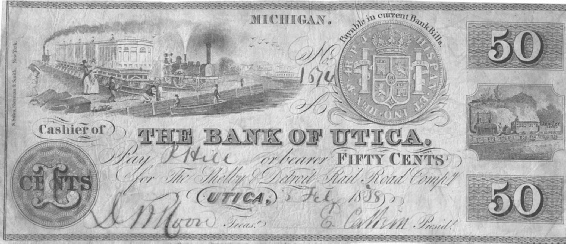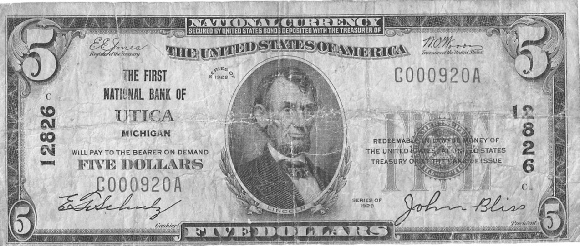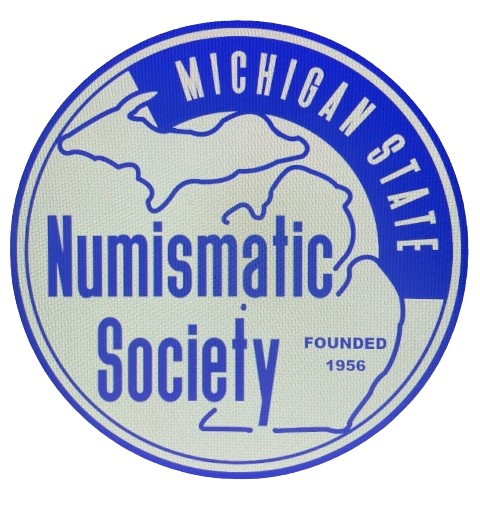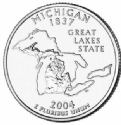THE RARE PAPER MONEY OF UTICA, MICHIGAN
By Daniel J. Sheffer
Mich-Matist Vol. XLVI No. 3 Summer 2010
In the past few years “buying local” seems to have become all the rage. In the first half of the nineteenth century consumers did not have much of a choice, they had to buy local. And they had to use local paper money to pay for the goods and services they wanted. These notes were accepted by the towns’ people at first. Why wouldn’t they be? You could go into the bank down the road and meet face-to-face with the men that signed the notes! They were your fellow townspeople.
Utica, Michigan was a typical pioneer town. Utica had been home to Native Americans until 1817 when the first settlers arrived. These men, women, and children cleared the land and planted crops. At first the settlers would have traded necessities amongst themselves. But by 1837 (the year Michigan became a state) the town had grown considerably. There was now a hotel, a railroad and many other businesses. The town needed a bank of it’s own to boost the local economy. The Bank of Utica was established August 31, 1837 in an old house on what is now Auburn Road. The bank opened with a capital of $50,000. The bank had to pay into a “safety fund” as stated on the notes, for the redemption of the notes. The bank was then given permission by the state to have its own currency printed, and $1, $2, and $5 notes were issued.
The railroad I mentioned above was named the Shelby and Detroit Railroad company. The rails ended at the Utica-Shelby Township boarder. While the train  cars ran on tracks much like today’s trains, the cars were pulled by horses! The railroad issued its own paper currency as well. Some collectors refer to these as “checks”. They could however circulate like paper money; therefore I consider them “notes”. These notes closely resemble the Bank of Utica notes, and came in twenty-five cent, fifty cent, $1, and $2 denominations. These notes were redeemable in “current Bank bills”. In other words you would trade them for notes of The Bank of Utica. The vignettes used on the 25 cent and 50 cent notes will be of interest to collectors of early coins. The 25 cent note shows the reverse of a Capped Bust quarter. The 50 cent note shows the reverse of a Mexican 4 Reales.
cars ran on tracks much like today’s trains, the cars were pulled by horses! The railroad issued its own paper currency as well. Some collectors refer to these as “checks”. They could however circulate like paper money; therefore I consider them “notes”. These notes closely resemble the Bank of Utica notes, and came in twenty-five cent, fifty cent, $1, and $2 denominations. These notes were redeemable in “current Bank bills”. In other words you would trade them for notes of The Bank of Utica. The vignettes used on the 25 cent and 50 cent notes will be of interest to collectors of early coins. The 25 cent note shows the reverse of a Capped Bust quarter. The 50 cent note shows the reverse of a Mexican 4 Reales.
The actual bank notes and the Shelby and Detroit Railroad notes had the name of the person being paid handwritten on them. But also said “or bearer”, therefore allowing them to be spent multiple times. And they were, until the bank and the railroad both failed! The bank was supposed to have backing for the notes. Apparently they lied about how much money they really had, and could not redeem the notes they issued. Imagine if tomorrow all the money in your wallet was worthless! And the reason they were worthless was that your neighbor the banker was not truthful. This was the nightmare of Utica citizens in 1839.
Once the bank was closed these notes were worthless paper. Many were lost, or thrown away. Fortunately a few of each denomination were saved. But all notes are very scarce today. I would estimate that the twenty-five cent note is the most common with maybe 10 notes known. The $5 Bank of Utica note is the scarcest with about 3 notes known.
After the closing of The Bank of Utica, other banks came and went in town. Then in 1929, well after the nightmare of the failing of The Bank of Utica had faded from memory, another Utica bank had notes with its name on them. This time the notes were backed by the U.S. Government. The First National Bank of Utica Michigan was chartered in 1925 and was given the charter number 12826. Notes were printed in $5 and $10 denominations. These notes look much like the Federal Reserve notes that circulated until the mid-1990s. The difference being they had a brown seal, the bank name, charter number, and the facsimile signatures of the local bank president and cashier. Unfortunately this bank, located at the corner of Auburn Road and Cass Ave., failed as well. This time it was due to the Great Depression in 1933. Because these notes were backed by the U.S. Government, almost all of the notes were returned and destroyed. Only three of the $5 notes and eight of the $10 notes are known to exist!
It is hard to place a value on these notes. They are very rare to say the least. However not everyone collects paper money from Michigan. All I have to go on is the prices I’ve paid dealers for the notes, and the number of notes I’ve seen offered in the past ten years. Therefore I estimate the values to be as follows: The bank of Utica one dollar $350, two dollar $500, five dollar $800. The Shelby and Detroit Railroad 25 cent $250, 50 cent note $250, one dollar $250, two dollar $400. The First National Bank of Utica five dollar $1,000, ten dollar $800.
is the prices I’ve paid dealers for the notes, and the number of notes I’ve seen offered in the past ten years. Therefore I estimate the values to be as follows: The bank of Utica one dollar $350, two dollar $500, five dollar $800. The Shelby and Detroit Railroad 25 cent $250, 50 cent note $250, one dollar $250, two dollar $400. The First National Bank of Utica five dollar $1,000, ten dollar $800.
I grew up in Shelby Township, just north of downtown Utica. While I found notes from Detroit and other cities that issued more notes interesting, I lived in the Utica area. I shopped in Utica. I wanted to collect Utica notes! I was 20 years old when I attended the 2005 M.S.N.S. show in Dearborn. A currency dealer gave me the address of a man that the dealer described as the “authority on Michigan paper money”, Dr. Wally Lee. This letter writing started a strong numismatic friendship between us. Wanting to retain me as a collector he advised me to collect a more “common” city. I wrote back and explained to Dr. Lee that it did not matter how long it took to find the notes; I wanted to collect Utica notes only. Over the next two years I purchased several Bank of Utica notes dated 1837 and 1838 from Dr. Lee. I wish I had purchased all his duplicate notes, but I did not.
At the 2006 M.S.N.S. show I was finally able to purchase a $5 and $10 First National Bank notes from Dr. Lee’s collection! These notes were unquestionably the rarest numismatic items at that show! In the four years since I purchased those two notes I have found and purchased two more $10 notes, and no other $5 notes. This means I own one of three $5 notes, and three of eight $10 notes! Not bad for just five years of collecting these scarce notes. It was a matter of being in the right place at the right time. These notes will now be in my personal collection for a very long time. This is the down side of collecting rare paper money, once in a collection; the notes often do not reappear on the market until after the collector passes away.
In 2008 I read an article in the local newspaper, Shelby-Utica News. The article stated that the Utica Heritage Association was gathering information on the history of Utica to publish a book. I contacted Gloria Olman who was in charge of the project. I invited her to my office to view the information I had gathered on Utica’s banks, and to view my collection of rare Utica bank notes. Besides the historic information I contributed, the book will also feature images of my Utica, MI paper money collection. The book will be released this June at a cost of just $32.
Order forms can be obtained at the Utica Public Library. Even if you don’t collect paper money this book will give you history on early banking, which will be interesting to any numismatist.
While I enjoy many areas of numismatics, I find these notes to be the most enjoyable. I do not collect them for investment. I enjoy looking at them, discussing them with fellow collectors, writing about them, and trying to learn more about them. I have a bank of Utica $1 note where part of the note is missing. But I enjoy looking at it just as much as I do the others. This note has a story to tell. When forming a collection of anything, do it for enjoyment, not profit.
Sources: Michigan Obsolete Bank and Scrip Notes of the 19th Century by Dr. Wallace G. Lee. Iola, Wisconsin: Krause, 2006.










 cars ran on tracks much like today’s trains, the cars were pulled by horses! The railroad issued its own paper currency as well. Some collectors refer to these as “checks”. They could however circulate like paper money; therefore I consider them “notes”. These notes closely resemble the Bank of Utica notes, and came in twenty-five cent, fifty cent, $1, and $2 denominations. These notes were redeemable in “current Bank bills”. In other words you would trade them for notes of The Bank of Utica. The vignettes used on the 25 cent and 50 cent notes will be of interest to collectors of early coins. The 25 cent note shows the reverse of a Capped Bust quarter. The 50 cent note shows the reverse of a Mexican 4 Reales.
cars ran on tracks much like today’s trains, the cars were pulled by horses! The railroad issued its own paper currency as well. Some collectors refer to these as “checks”. They could however circulate like paper money; therefore I consider them “notes”. These notes closely resemble the Bank of Utica notes, and came in twenty-five cent, fifty cent, $1, and $2 denominations. These notes were redeemable in “current Bank bills”. In other words you would trade them for notes of The Bank of Utica. The vignettes used on the 25 cent and 50 cent notes will be of interest to collectors of early coins. The 25 cent note shows the reverse of a Capped Bust quarter. The 50 cent note shows the reverse of a Mexican 4 Reales. is the prices I’ve paid dealers for the notes, and the number of notes I’ve seen offered in the past ten years. Therefore I estimate the values to be as follows: The bank of Utica one dollar $350, two dollar $500, five dollar $800. The Shelby and Detroit Railroad 25 cent $250, 50 cent note $250, one dollar $250, two dollar $400. The First National Bank of Utica five dollar $1,000, ten dollar $800.
is the prices I’ve paid dealers for the notes, and the number of notes I’ve seen offered in the past ten years. Therefore I estimate the values to be as follows: The bank of Utica one dollar $350, two dollar $500, five dollar $800. The Shelby and Detroit Railroad 25 cent $250, 50 cent note $250, one dollar $250, two dollar $400. The First National Bank of Utica five dollar $1,000, ten dollar $800.